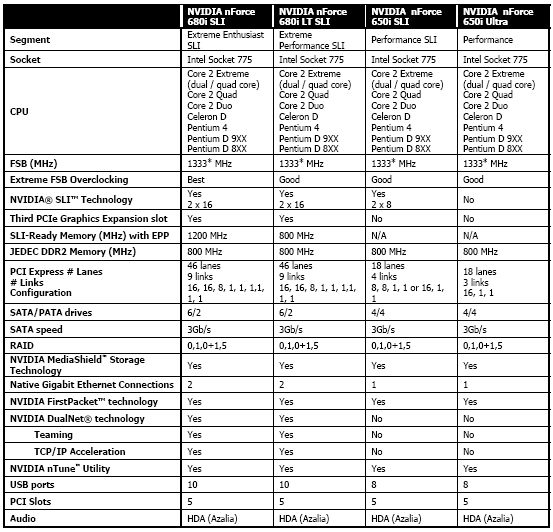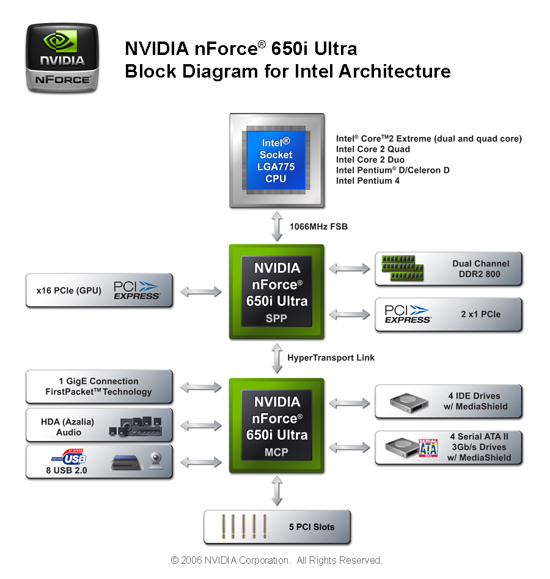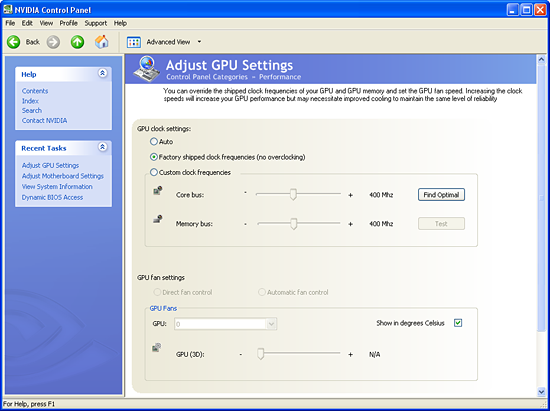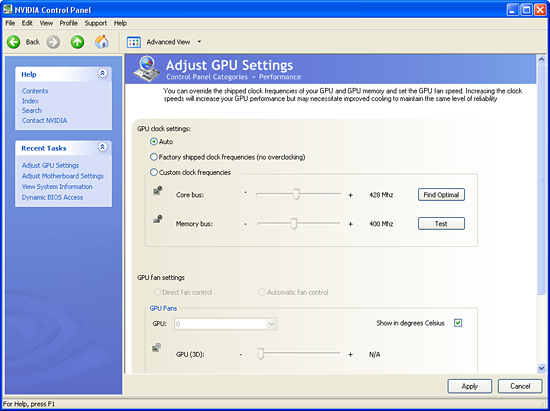EVGA nForce 650i Ultra: Performance on a Budget
by Gary Key on April 10, 2007 2:00 AM EST- Posted in
- Motherboards
NVIDIA nForce 650i Ultra Chipset Features
Before we get to our initial performance results and discussion of this budget 650i Ultra board design we need to first explain the differences between it and the other Intel chipset offerings from NVIDIA.

All of the chipsets offer support for the latest Intel Socket 775 based processors along with official 1333FSB speeds for the upcoming 1333FSB based CPUs. The 650i SLI and 650i Ultra chipsets are based on the same 650i SPP and utilize the nF430 MCP. The only differentiator between the two is how this SPP/MCP combination is implemented on a board with the 650i SLI offering SLI operation at 8x8 compared to the single x16 slot on the 650i Ultra.
Other differences between the chipsets center on the features that the 680i offers that are not available on the 650i. These features include two additional USB 2.0 ports, two additional SATA ports, an additional Gigabit Ethernet port, Dual-Net technology, and EPP memory support. Otherwise, depending upon BIOS tuning, the performance of the chipsets is very similar across a wide range of applications, with overclocking capabilities being slightly more pronounced on the 680i chipset. In our testing we have found that the other chipsets also offer very good overclocking capabilities with SLI performance basically being equal at common resolutions on supported chipsets.

This diagram lists the basic features of the 650i Ultra chipset. The differences between the available options and our EVGA 650i Ultra board is the removal of an IDE port that would support two additional PATA drives and two less PCI slots. The inclusion of the additional IDE port could have benefited this board considering the price range, particularly for those interested in using older IDE hard drives to keep upgrade costs down.


One of the new features being implemented by NVIDIA with the 650i Ultra release is an automatic GPU optimization capability. These optimizations are handled automatically by the GPU and board driver sets based upon the installed GPU and BIOS support. Initial support is for the 7600GS and 7300GT video cards but it will be expanded across a wider range of NVIDIA based graphic cards in the near future. We will also see more aggressive tuning as this technology matures over time.
The drivers will determine a safe overclocking level for the GPU and then implement the changes automatically. This support is transparent to the user and works seamlessly. We tested this feature exhaustively across a wide range of applications and it never once created an issue. These optimizations provided a 2% to 4% improvement in our game benchmark scores.
Obviously, the more astute computer user can get the same or better results by manually overclocking the GPU which is why some users will probably think of this as a gimmick. However, we believe any time you can gain performance at no cost or effort then there's not reason to complain.
Before we get to our initial performance results and discussion of this budget 650i Ultra board design we need to first explain the differences between it and the other Intel chipset offerings from NVIDIA.

All of the chipsets offer support for the latest Intel Socket 775 based processors along with official 1333FSB speeds for the upcoming 1333FSB based CPUs. The 650i SLI and 650i Ultra chipsets are based on the same 650i SPP and utilize the nF430 MCP. The only differentiator between the two is how this SPP/MCP combination is implemented on a board with the 650i SLI offering SLI operation at 8x8 compared to the single x16 slot on the 650i Ultra.
Other differences between the chipsets center on the features that the 680i offers that are not available on the 650i. These features include two additional USB 2.0 ports, two additional SATA ports, an additional Gigabit Ethernet port, Dual-Net technology, and EPP memory support. Otherwise, depending upon BIOS tuning, the performance of the chipsets is very similar across a wide range of applications, with overclocking capabilities being slightly more pronounced on the 680i chipset. In our testing we have found that the other chipsets also offer very good overclocking capabilities with SLI performance basically being equal at common resolutions on supported chipsets.

This diagram lists the basic features of the 650i Ultra chipset. The differences between the available options and our EVGA 650i Ultra board is the removal of an IDE port that would support two additional PATA drives and two less PCI slots. The inclusion of the additional IDE port could have benefited this board considering the price range, particularly for those interested in using older IDE hard drives to keep upgrade costs down.


One of the new features being implemented by NVIDIA with the 650i Ultra release is an automatic GPU optimization capability. These optimizations are handled automatically by the GPU and board driver sets based upon the installed GPU and BIOS support. Initial support is for the 7600GS and 7300GT video cards but it will be expanded across a wider range of NVIDIA based graphic cards in the near future. We will also see more aggressive tuning as this technology matures over time.
The drivers will determine a safe overclocking level for the GPU and then implement the changes automatically. This support is transparent to the user and works seamlessly. We tested this feature exhaustively across a wide range of applications and it never once created an issue. These optimizations provided a 2% to 4% improvement in our game benchmark scores.
Obviously, the more astute computer user can get the same or better results by manually overclocking the GPU which is why some users will probably think of this as a gimmick. However, we believe any time you can gain performance at no cost or effort then there's not reason to complain.










18 Comments
View All Comments
kentster2 - Wednesday, April 18, 2007 - link
This motherboard sounds perfect for me but I can't find it anywhere. In fact I can't find any boards based on the 650i Ultra chipset available anywhere. I did find the specs on an MSI board based on this chipset but again no availability. Does anyone know when the general availability will be for these boards?yyrkoon - Thursday, April 12, 2007 - link
Still does not compare to the best AM2 'budget' board out there. Add the following, and it would do good I think:1) Heatpipe cooled chipset
2) Either one more PATA port, or 2 more SATA ports for a total of 8 drives
3) Firewire ( not supported ?! )
4) Overclocking options out the wazzu, with memeory voltages capable of 3.0v
Are the PATA ports controlled by the 430MCP ? It seems that way, going by the features list. If this is the case, WHY leave out a PATA port ? It does not make sense. These four things I've mentioned above are not too much to ask, ABIT has already proven that with the NF-M2 nView, and places like newegg, ZZF, etc can not seem to keep these boards in stock ! What gives . . .
kmmatney - Wednesday, April 11, 2007 - link
it;s obvious that having a high priced sound card will help out with frame rates, but what about a cheaper card? Would a $27 Creative Audigy SE provide the same speed benefits by taking the load from the cpu?Gary Key - Wednesday, April 11, 2007 - link
The SE will provide frame rates that are on average about 2~3% worse than the X-FI in my experiences.lopri - Tuesday, April 10, 2007 - link
Gary's measure is remarkably similar to my observations on EVGA 680i board. (Interesting because the chips used on the 680i SLI are different from 650i Ultra) Without active cooling, I saw SPP temp rising to 100C(!) and MCP to 80C. This will not only cause instability (especially mated with other high-end components) but likely shorten the lifespan of the board. Even more worrisome is that the ever-increasing popularity of those L-shaped HSFs. These HSFs provide practically zero air-flow on the board's hot (i mean, HOT) spots and therefore the heat keeps building up.
I think NV at this point just assume that their target audience are *enthusiasts* in that:
1. Enthusiasts today just accept that a new motherboard/chipset is basically a beta product and expect fix/patches via BIOS updates and/or hardware revision.
2. Enthusiasts tend to employ their own cooling solution anyway.
And that's exactly what I've done up to this date. Every single NV chipset board I bought the first thing I did was replacing stock chipset/VRM cooling with aftermarket stuff.
And I'M TIRED OF IT.
This board may be selling for $99, but in order for you to build your main rig with a peace of mind on it, you will need an aftermarket cooling for the missing SB HSF (how dare they leave it wide open like that is beyond me) and the paltry NB heatsink for a heavier one. There goes extra $20~30 quite easily.
To my eyes, this board cut so many corners and definitely not worth $99. $70~80 maybe. And I do think that's how much it'll sell for in less than a month.
nullpointerus - Wednesday, April 11, 2007 - link
When it's included, active cooling's crap anyway. The little NB/SB fans last a few months at most before giving out completely. Motherboard makers should get in touch with Zalman or somebody like them and get some decent quality HSF's on these boards.jay401 - Wednesday, April 11, 2007 - link
Totally agree! It would be stupid to buy a motherboard that requires you buy other items just to ensure stable operation and longevity.Scarceas - Tuesday, April 10, 2007 - link
Really, who needs 2.2V? If you have RAM that needs that much voltage, chances are you paid more money for it, and the board you are looking to use it with will probably not be a budget board.WT - Tuesday, April 10, 2007 - link
I have an eVGA N41 board, so I want to like this thing, but looking at this 650 board .. blechhh .. talk about plain Jane !! It looks like a straight reference board or an Intel board ! Regardless of looks, performance is what we want, so I would refer anyone looking at this board to read Anand's earlier article on the MSI P6N Platinum and see if that isn't a better fit for your needs. The extra $40-50 is well justified (in my case at least) with the better cooling setup on the MSI board as well as Firewire (just bought a miniDV camcorder) so give that a read as well.If the MSI Plat is priced too high, then check out the FI board priced at $108 at popular vendors websites.
Pirks - Tuesday, April 10, 2007 - link
Gary, E6300 has TWO megabytes of cache, not FOUR